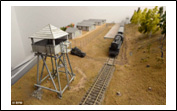
Tabitha Korol
Train of thought
By Tabitha Korol
Of the many kinds of trains exhibited in Birmingham's Wonderful World of Trains and Planes, in Birmingham, England, the only display in dispute was the model train set of Auschwitz, noted the Daily Mail. The photos included in the column certainly verify that the set was painstakingly designed to provide authenticity, was sufficiently informative, and respectfully and tastefully executed. Although I have visited Auschwitz, I have seen an authentic and replicas of boxcars in other museums, not to mention in newsreels, so I was dismayed to learn that only this one was considered objectionable.
 One such objection came from a Holocaust survivor and while my heart goes out to him, this was an important teaching moment that would not be obtained in a classroom or home environment, and must not be obliterated from collective memory. It is not the presentation, but the Holocaust itself that is offensive. The mass murder of millions of innocent men, women, and children is inconceivably offensive. The obliteration of human beings by fascists – and now by Islamo-fascists – is severely offensive. And last year, I was privileged to edit a book of Holocaust survivors' memoirs that were immensely offensive, but surely not to be dismissed or disregarded.
One such objection came from a Holocaust survivor and while my heart goes out to him, this was an important teaching moment that would not be obtained in a classroom or home environment, and must not be obliterated from collective memory. It is not the presentation, but the Holocaust itself that is offensive. The mass murder of millions of innocent men, women, and children is inconceivably offensive. The obliteration of human beings by fascists – and now by Islamo-fascists – is severely offensive. And last year, I was privileged to edit a book of Holocaust survivors' memoirs that were immensely offensive, but surely not to be dismissed or disregarded.
The visitors from Birmingham and environs elected not to stay at home in front of the telly, or go to the park, or attend a sporting event. Rather, they chose to visit a museum, to expand their horizons, to see and learn something new. So, while I respect the wishes and painful memories of the dissenting gentleman and the parents who prefer to keep their children ignorant of this part of human history, this may well have been the last thing ever seen by about one-and-a-half-million children during World War II, and I believe there is much to be gained by viewing the display.
Taking this a step further, if the exhibit were of sailing vessels, I would expect to see crafts of all kinds – those that carried goods and those that carried human cargo, those designed for peacetime and those designed for wartime:
© Tabitha Korol
March 2, 2015
Of the many kinds of trains exhibited in Birmingham's Wonderful World of Trains and Planes, in Birmingham, England, the only display in dispute was the model train set of Auschwitz, noted the Daily Mail. The photos included in the column certainly verify that the set was painstakingly designed to provide authenticity, was sufficiently informative, and respectfully and tastefully executed. Although I have visited Auschwitz, I have seen an authentic and replicas of boxcars in other museums, not to mention in newsreels, so I was dismayed to learn that only this one was considered objectionable.
 One such objection came from a Holocaust survivor and while my heart goes out to him, this was an important teaching moment that would not be obtained in a classroom or home environment, and must not be obliterated from collective memory. It is not the presentation, but the Holocaust itself that is offensive. The mass murder of millions of innocent men, women, and children is inconceivably offensive. The obliteration of human beings by fascists – and now by Islamo-fascists – is severely offensive. And last year, I was privileged to edit a book of Holocaust survivors' memoirs that were immensely offensive, but surely not to be dismissed or disregarded.
One such objection came from a Holocaust survivor and while my heart goes out to him, this was an important teaching moment that would not be obtained in a classroom or home environment, and must not be obliterated from collective memory. It is not the presentation, but the Holocaust itself that is offensive. The mass murder of millions of innocent men, women, and children is inconceivably offensive. The obliteration of human beings by fascists – and now by Islamo-fascists – is severely offensive. And last year, I was privileged to edit a book of Holocaust survivors' memoirs that were immensely offensive, but surely not to be dismissed or disregarded.The visitors from Birmingham and environs elected not to stay at home in front of the telly, or go to the park, or attend a sporting event. Rather, they chose to visit a museum, to expand their horizons, to see and learn something new. So, while I respect the wishes and painful memories of the dissenting gentleman and the parents who prefer to keep their children ignorant of this part of human history, this may well have been the last thing ever seen by about one-and-a-half-million children during World War II, and I believe there is much to be gained by viewing the display.
Taking this a step further, if the exhibit were of sailing vessels, I would expect to see crafts of all kinds – those that carried goods and those that carried human cargo, those designed for peacetime and those designed for wartime:
- The dhow, the traditional sailing and trading vessel, c. 600 BC – 600 AD, invented by Chinese, Arabs or Indians;
- The vessels of the Polynesians, who were the finest navigators of the time;
- Ships of the explorers, Vikings, Vasco de Gama, Marco Polo, and Christopher Columbus;
- Muslim slave ships that brought Africans to Europe and America;
- The Barbary pirate ships, the menace that attacked ports, captured people for slavery, and plundered merchant ships.
- The American Navy ships dispatched by President Thomas Jefferson to battle the Barbary pirates;
- The Mississippi River boats and barges that transported slaves through the States;
- The MS St. Louis, the German ocean liner noted for its 1939 voyage in which her captain, Gustav Schroder, tried to find homes for 915 Jewish refugees who were denied entry to Cuba, the US, and Canada;
- The First Class, "unsinkable" Titanic luxury liner.
- Samples of warships, trading vessels, aircraft carriers and submarines, and any other ships noteworthy through our human history.
© Tabitha Korol
The views expressed by RenewAmerica columnists are their own and do not necessarily reflect the position of RenewAmerica or its affiliates.
(See RenewAmerica's publishing standards.)




















